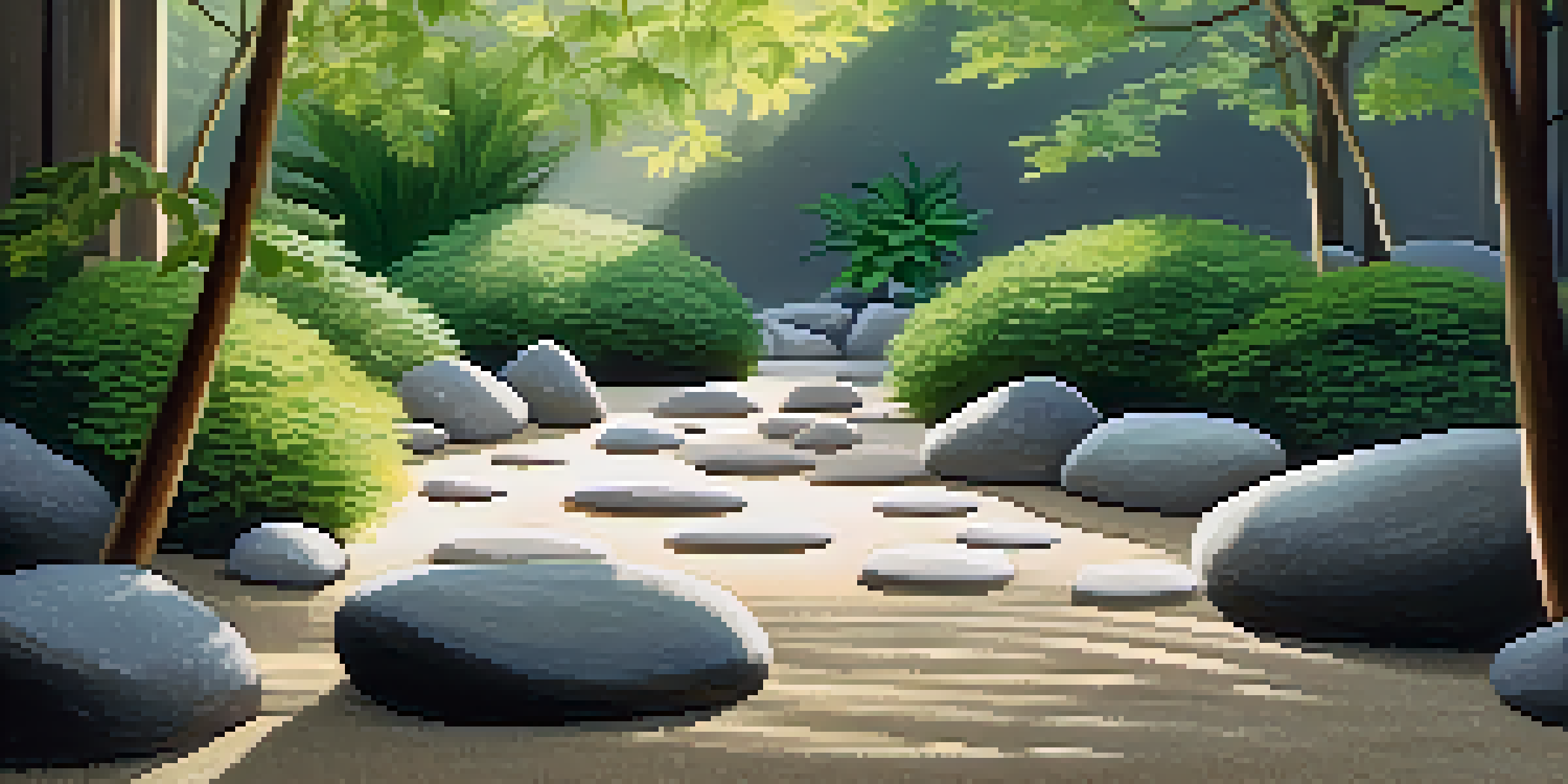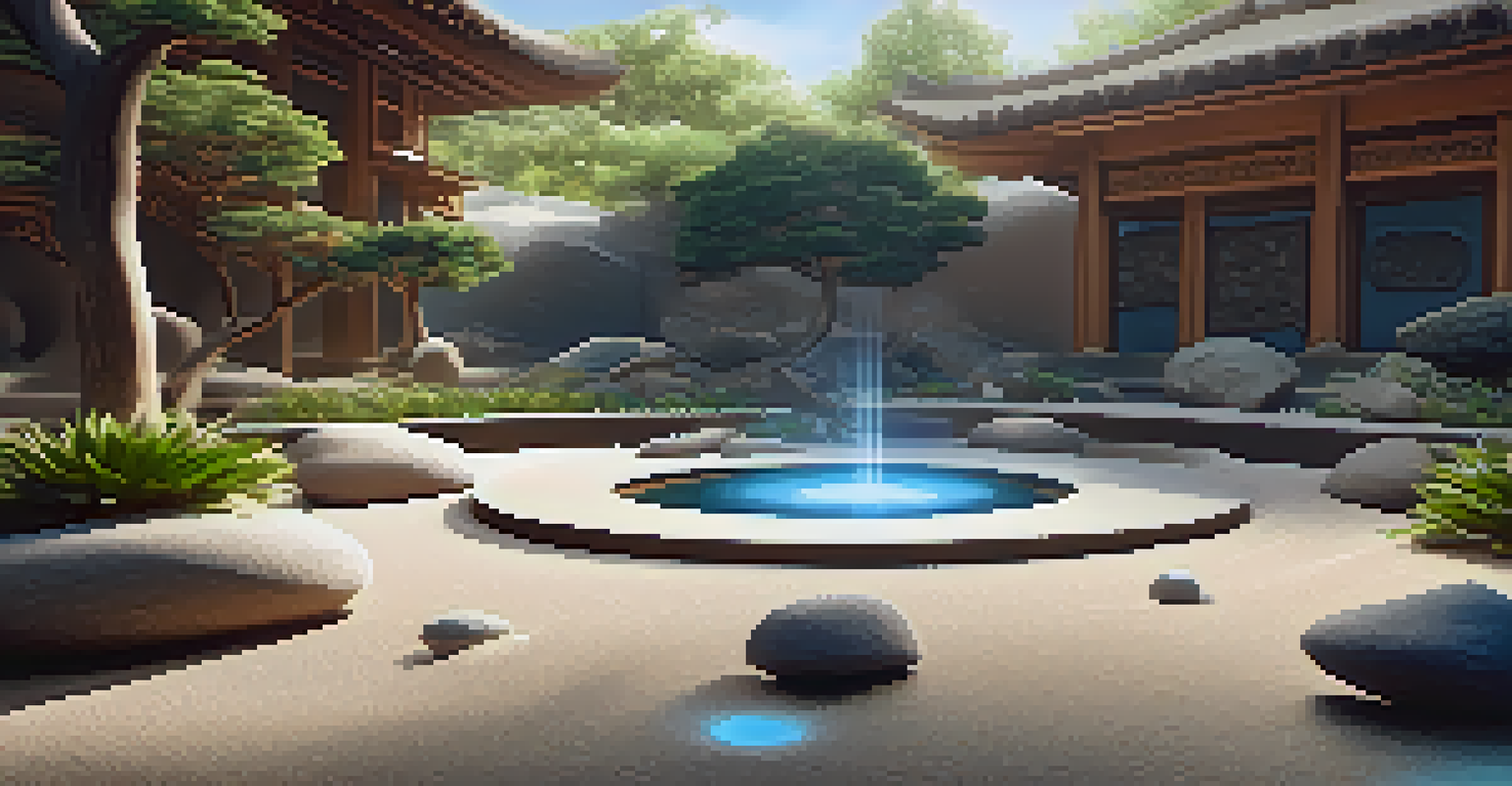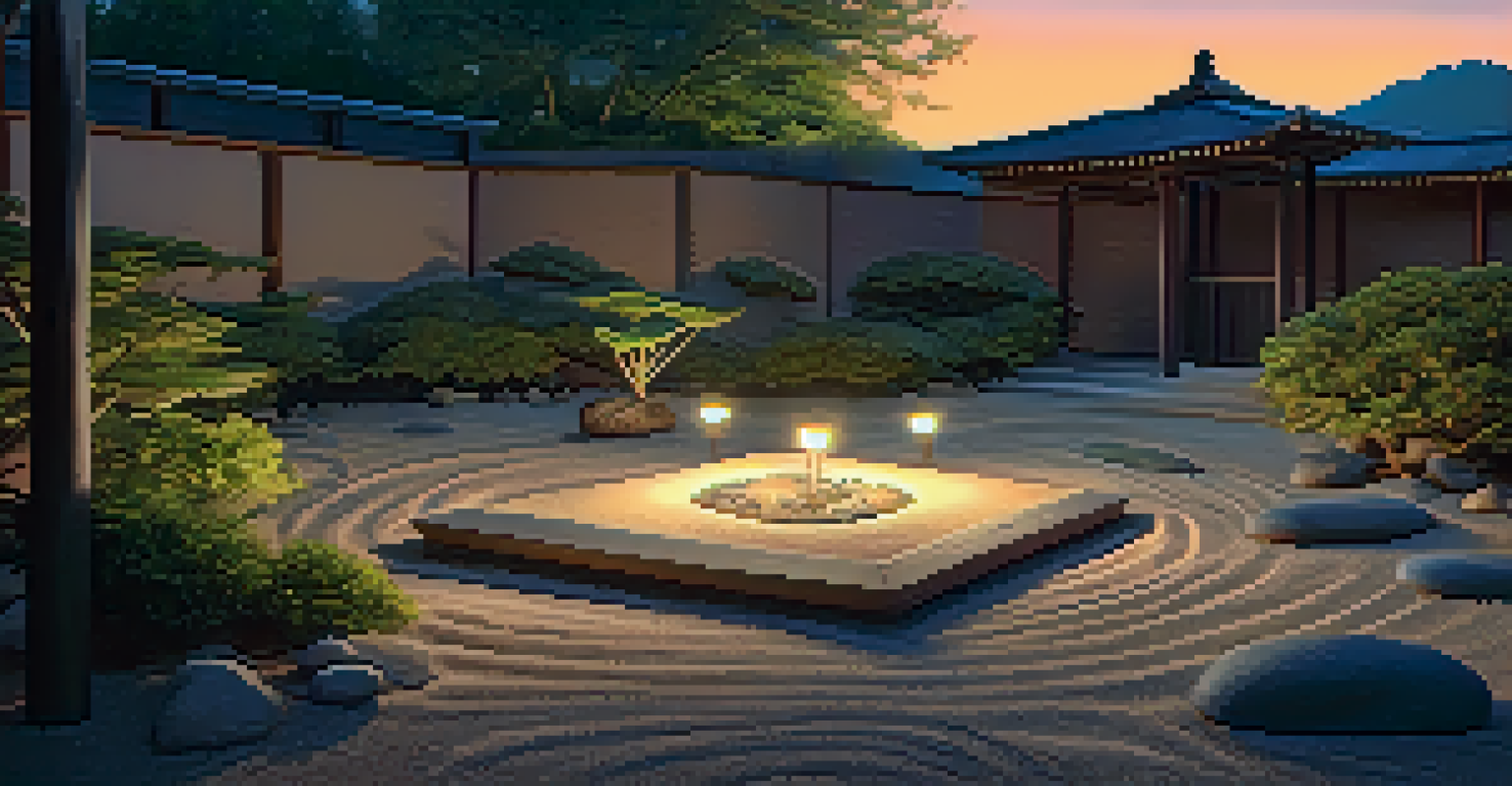Designing a Zen Garden: Digital Tools for Tranquility

Understanding the Essence of Zen Gardens
Zen gardens, or karesansui, are a beautiful representation of Japanese culture, designed primarily for meditation and reflection. They use minimal materials like rocks, gravel, and sand to create a tranquil space that encourages mindfulness. The essence of these gardens lies in their simplicity, allowing the mind to find peace amidst natural beauty.
The quieter you become, the more you can hear.
The minimalist approach focuses on representation rather than reality, symbolizing mountains, rivers, and islands through carefully arranged elements. This abstraction helps foster a deeper connection with nature and oneself, making Zen gardens a perfect retreat from the hustle and bustle of everyday life. By understanding this essence, you can appreciate the calming influence they provide.
Incorporating digital tools can elevate your design process, allowing you to visualize and experiment with various layouts effortlessly. From 3D modeling software to apps that simulate natural environments, these tools can bring your Zen garden vision to life while preserving its tranquil spirit.
Choosing the Right Digital Tools for Your Zen Garden
When embarking on your Zen garden journey, selecting the right digital tools is crucial. Programs like SketchUp or AutoCAD offer robust features for 3D modeling, allowing you to manipulate and visualize your garden from different angles. For those seeking a more straightforward approach, garden design apps like Garden Planner can simplify the process.

These tools can help you experiment with various elements, such as rock placement, plant selection, and sand patterns, without the need for physical changes. By using digital resources, you can save time and effort while ensuring your design reflects the calming aesthetics of a traditional Zen garden. Plus, the ability to undo changes means you can explore creativity without fear.
Zen Gardens Promote Mindfulness
Zen gardens, through their simplicity and natural elements, create tranquil spaces that encourage meditation and self-reflection.
As you choose your tools, consider your level of experience and comfort with technology. Some platforms cater to beginners, while others offer advanced features for seasoned designers. Finding the right balance will help you create a serene digital workspace that mirrors the tranquility you seek in your physical garden.
Visualizing Your Zen Garden Layout Digitally
Visualization is a vital step in the design process, and digital tools excel at bringing your ideas to life. Start by sketching your initial thoughts, then move to digital platforms to refine your layout. This step allows you to see how different elements interact, helping you achieve a harmonious design.
Nature does not hurry, yet everything is accomplished.
Incorporating layers in your design can enhance the depth and complexity of your garden. For example, you might use one layer for rocks, another for sand patterns, and a third for plants. This modular approach not only simplifies your design but also helps you visualize how each element contributes to the overall tranquility of the space.
Don't forget to utilize features like color palettes and textures offered by many design tools. These elements can provide insight into how your Zen garden will look in different lighting conditions, allowing you to make informed choices that enhance the calming atmosphere you're aiming for.
Incorporating Natural Elements into Your Design
A successful Zen garden is one that harmonizes natural elements with digital design. While digital tools can help you create a layout, it's important to select materials and plants that resonate with the principles of Zen. Consider incorporating natural stones, gravel, and native plants that thrive in your local environment.
Digital platforms can often provide resources for understanding how different materials will behave over time. For instance, you can explore which types of gravel are best for drainage or which plants will require the least maintenance. This knowledge ensures that your garden remains serene and visually appealing without excessive upkeep.
Digital Tools Enhance Design Process
Utilizing digital tools for designing Zen gardens allows for easy experimentation with layouts and elements, streamlining the creative process.
By blending digital design with natural elements, you can create a space that not only looks beautiful but also promotes a sense of peace and calm. This connection to nature is at the heart of Zen gardening and can be effectively achieved through thoughtful planning and execution.
Utilizing Virtual Reality for Immersive Experiences
Virtual reality (VR) technology is transforming how we approach garden design, providing immersive experiences that can enhance creativity. With VR, you can step into your digital Zen garden before it's built, allowing you to experience the space as if it were real. This firsthand experience can significantly influence design decisions.
Imagine walking through your garden, feeling the textures underfoot and observing how sunlight interacts with different elements. Such experiences can help you identify areas needing adjustment, ensuring that your final design aligns with your vision of tranquility. The ability to visualize and interact with your garden in a virtual space is a game-changer.
As this technology becomes more accessible, consider exploring VR tools that offer garden design features. These platforms can provide a unique opportunity to refine your design, ensuring that your Zen garden is not only aesthetically pleasing but also a true sanctuary for relaxation and reflection.
Collaborating with Others Using Digital Tools
Designing a Zen garden can be a solitary endeavor, but it doesn't have to be. Digital tools allow for collaboration with friends, family, or gardening communities, enabling you to gather diverse perspectives on your design. Sharing ideas and receiving feedback can enrich your creative process and lead to a more fulfilling outcome.
Platforms like Google SketchUp enable multiple users to work on a design simultaneously, making it easy to brainstorm and implement changes in real-time. Collaboration can bring fresh ideas to the table, helping you to consider elements you might not have thought of on your own. This can lead to a more dynamic and engaging design process.
Balance Digital and Physical Gardening
It's important to maintain a balance between digital planning and hands-on gardening to truly cultivate a peaceful Zen garden experience.
Moreover, discussing your design with others can help you stay motivated and inspired. Whether you’re sharing on social media or collaborating in person, the support and insights of a community can make your Zen garden journey more enjoyable and enriching.
Maintaining Digital and Physical Balance in Your Zen Garden
As you design your Zen garden, it's essential to strike a balance between digital planning and physical execution. While digital tools offer convenience and creativity, they should complement, not replace, the hands-on experience of gardening. Engaging with nature through physical labor can be therapeutic and grounding.
As you transition from digital designs to real-life implementation, consider how your plans translate into the physical world. The tactile experience of arranging stones, raking sand, or planting can deepen your connection to the garden. It’s in these moments that the true essence of a Zen garden comes to life.

Ultimately, the goal is to create a space that promotes tranquility and reflection, both in the digital realm and the physical world. By embracing both aspects, you can cultivate a Zen garden that not only looks beautiful but also serves as a genuine sanctuary for peace and mindfulness.